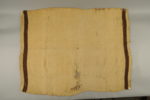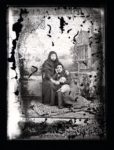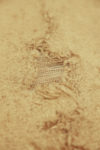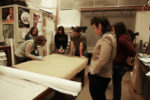 Researchers at the Burke Museum of Natural History and Culture in Seattle, Washington, have confirmed that a Coast Salish blanket in its collection was woven from the fur of the woolly dog. Woolly dogs were carefully bred and husbanded for centuries by the Coast Salish peoples of the Pacific Northwest, who sheared them like sheep and used their thick, long fur to weave textiles. Because the trait for this woollen hair was recessive, the Salish were meticulous about keeping the woolly dogs separate from their hunting dogs to ensure the continuation of the genetic line.
Researchers at the Burke Museum of Natural History and Culture in Seattle, Washington, have confirmed that a Coast Salish blanket in its collection was woven from the fur of the woolly dog. Woolly dogs were carefully bred and husbanded for centuries by the Coast Salish peoples of the Pacific Northwest, who sheared them like sheep and used their thick, long fur to weave textiles. Because the trait for this woollen hair was recessive, the Salish were meticulous about keeping the woolly dogs separate from their hunting dogs to ensure the continuation of the genetic line.
 Explorer George Vancouver encountered the Coast Salish and their marvelous woolly dogs in May of 1792 during his expedition to the Pacific Northwest. He was in Puget Sound on the south end of Bainbridge Island when he met a small group of Coast Salish on the move with all their earthly possessions. Their dogs squeezed into the single canoe with them. In his account of the expedition, Vancouver describes the animals thus:
Explorer George Vancouver encountered the Coast Salish and their marvelous woolly dogs in May of 1792 during his expedition to the Pacific Northwest. He was in Puget Sound on the south end of Bainbridge Island when he met a small group of Coast Salish on the move with all their earthly possessions. Their dogs squeezed into the single canoe with them. In his account of the expedition, Vancouver describes the animals thus:
The dogs belonging to this tribe of Indians were numerous, and much resembled those of Pomerania, though in general somewhat larger. They were all shorn as close to the skin as sheep are in England; and so compact were their fleeces, that large portions could be lifted up by a corner without causing any separation. They were composed of a mixture of a coarse kind of wool, with very fine long hair, capable of being spun into yarn.
 When the Europeans arrived, 1,000 years of Mendelian curation broke down irretrievably. Displacement of tribes, uncontrolled mixing with dogs brought by explorers and traders and introduced diseases devastated the breed. By the end of the 19th century, the woolly dog was extinct.
When the Europeans arrived, 1,000 years of Mendelian curation broke down irretrievably. Displacement of tribes, uncontrolled mixing with dogs brought by explorers and traders and introduced diseases devastated the breed. By the end of the 19th century, the woolly dog was extinct.
 Because textiles are delicate and so many of them were sold, discarded or destroyed, the rich tradition of Coast Salish woolly dog weaving was reduced to a few items in scattered museums, and even fewer of them have been confirmed to have been made with woolly dog hair. In 2011, seven pieces in the collections of the Smithsonian Institution, some collected during the Lewis and Clark expedition, were discovered through microscopic examination to have woolly dog hair in them. The Burke’s blanket is the only object in a Northwest museum confirmed to have been woven from woolly dog hair, which is enormously exciting to researchers and Coast Salish weavers who will finally have the opportunity to study an ancient craft in the place where it was developed and practiced for a thousand years.
Because textiles are delicate and so many of them were sold, discarded or destroyed, the rich tradition of Coast Salish woolly dog weaving was reduced to a few items in scattered museums, and even fewer of them have been confirmed to have been made with woolly dog hair. In 2011, seven pieces in the collections of the Smithsonian Institution, some collected during the Lewis and Clark expedition, were discovered through microscopic examination to have woolly dog hair in them. The Burke’s blanket is the only object in a Northwest museum confirmed to have been woven from woolly dog hair, which is enormously exciting to researchers and Coast Salish weavers who will finally have the opportunity to study an ancient craft in the place where it was developed and practiced for a thousand years.
 Not much is known about the ownership history of the blanket. It was once part of the collection of Native American artifacts assembled by none other than Judge James Wickersham, who is best known today as the first federal judge of the newly formed Third District covering Alaska and his tireless advocacy for Alaskan statehood, but who was a Washington state representative before that and lived in Tacoma from 1883 until 1900. (While he lived there, he was involved in one of Tacoma’s most ignoble incidents. Wickersham was part of the mob of white residents who forcibly expelled all the Chinese from Tacoma in 1885. He was one of the ringleaders, in fact, one of the so-called Tacoma 27, who were
Not much is known about the ownership history of the blanket. It was once part of the collection of Native American artifacts assembled by none other than Judge James Wickersham, who is best known today as the first federal judge of the newly formed Third District covering Alaska and his tireless advocacy for Alaskan statehood, but who was a Washington state representative before that and lived in Tacoma from 1883 until 1900. (While he lived there, he was involved in one of Tacoma’s most ignoble incidents. Wickersham was part of the mob of white residents who forcibly expelled all the Chinese from Tacoma in 1885. He was one of the ringleaders, in fact, one of the so-called Tacoma 27, who were  arrested and prosecuted but never convicted.)
arrested and prosecuted but never convicted.)
After Wickersham’s death in Juneau in 1939, his collection was sold to a tourist store in Alaska. Another collector recognized the historical and cultural importance of the objects and acquired them. In 1975, they were donated to the Burke Museum. The blanket has a simple design — two brown selvages on the far left and right against a creamy-buttery background — but the lucky break came in the form of a small tear.
Unlike many plaited Coast Salish blankets, the blanket is twined (meaning that the weaver used two horizontal “weft” yarns, one passing in front while the other passes behind the vertical “warp” yarn).
“As soon as I saw the warp yarns exposed by the tear, I knew this was an unusual blanket” said Liz Hammond-Kaarremaa, a Coast Salish spinning expert. Hammond-Kaarremaa received a grant through the Museum’s Bill Holm Center to study Coast Salish blankets and robes in the Burke collection. The unusual warp in this blanket is made from a combination of string, bark and sinew. As she pored over the blanket, she began to suspect the materials used to weave it may also have included woolly dog hair. “The warp caught my attention but it was the weft that posed the mystery: the weft fiber did not look like mountain goat, nor did it look like sheep wool. It looked like woolly dog hair I had seen at the Smithsonian.”
 The Burke enlisted the aid of Elaine Humphrey and Terrence Loychuk from the University of Victoria Advanced Microscopy Facility to study the blanket’s fibers. They’ve examined several Coast Salish blankets using light and scanning electron microscopy. Advanced microscopic analysis confirmed the woolly dog hair.
The Burke enlisted the aid of Elaine Humphrey and Terrence Loychuk from the University of Victoria Advanced Microscopy Facility to study the blanket’s fibers. They’ve examined several Coast Salish blankets using light and scanning electron microscopy. Advanced microscopic analysis confirmed the woolly dog hair.
“This exciting discovery brings attention to a fascinating piece of Northwest history, and connects the Burke’s collections to this unique, Coast Salish tradition,” said Dr. Kathryn Bunn-Marcuse, Burke Museum curator of Northwest Native art. “We look forward to sharing the blanket with weavers and other researchers, so that it can be reconnected to the Indigenous knowledge systems from which it came.”
The blanket will be on display this weekend as part of the Burke’s new Testing, Testing 1-2-3 exhibition. Burke ethnologists will be there on Saturday from 11:00 AM until noon to answer questions about the blanket and the Coast Salish woolly dog hair tradition.